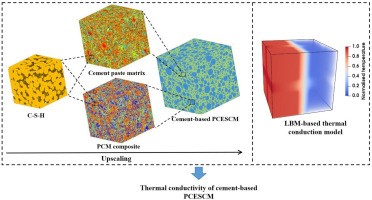当前位置:
X-MOL 学术
›
Mater. Des.
›
论文详情
Our official English website, www.x-mol.net, welcomes your
feedback! (Note: you will need to create a separate account there.)
Multi-scale modelling of thermal conductivity of phase change material/recycled cement paste incorporated cement-based composite material
Materials & Design ( IF 7.6 ) Pub Date : 2020-06-01 , DOI: 10.1016/j.matdes.2020.108646 Cheng Liu , Rusheng Qian , Zhiyong Liu , Guojian Liu , Yunsheng Zhang
Materials & Design ( IF 7.6 ) Pub Date : 2020-06-01 , DOI: 10.1016/j.matdes.2020.108646 Cheng Liu , Rusheng Qian , Zhiyong Liu , Guojian Liu , Yunsheng Zhang

|
Abstract Recycled cement paste as a promising shape stabilisation support of phase change material (PCM) has been introduced to prepare cement-based phase change energy storage composite material (PCESCM) due to its advantages regarding building energy conservation and recycling construction waste. In this study, to fully consider the degrees of freedom of material design, a multi-scale framework using lattice Boltzmann method (LBM) is proposed to predict the effective thermal conductivities of hierarchical cement-based PCESCM. The representative volume elements (RVEs) of cement-based PCESCM covering nano-, micro-, and meso-scale are established capturing the complex structural characteristics. Afterwards, an LBM-based thermal conduction model is proposed to simulate the thermal conduction through the reconstructed RVEs. The results indicate that at the nano-scale the thermal conductivity of colloidal C-S-H increases with the packing density of gel particles for both saturated and dried states. At the micro-scale, the thermal conductivities of matrix and PCM composite are highly dependent on the degree of water/PCM saturation. At the meso-scale, the incorporation of PCM composites can lead to a reduction in thermal conductivity. In general, the simulated thermal conductivities of hierarchical cement-based PCESCM using the LBM-based model agree well with the measured values or the estimated results using the analytical model.
中文翻译:

相变材料/再生水泥浆掺入水泥基复合材料热导率的多尺度建模
摘要 再生水泥浆体作为相变材料(PCM)的有前途的形状稳定载体,由于其在建筑节能和建筑垃圾回收利用方面的优势,已被引入以制备水泥基相变储能复合材料(PCESCM)。在这项研究中,为了充分考虑材料设计的自由度,提出了一种使用格子玻尔兹曼方法 (LBM) 的多尺度框架来预测分层水泥基 PCESCM 的有效热导率。建立了涵盖纳米、微米和中尺度的水泥基 PCESCM 的代表性体积元素 (RVE),以捕捉复杂的结构特征。然后,提出了基于 LBM 的热传导模型来模拟通过重建的 RVE 的热传导。结果表明,在纳米尺度上,胶体 CSH 的热导率随着凝胶颗粒在饱和和干燥状态下的堆积密度而增加。在微观尺度上,基体和 PCM 复合材料的热导率高度依赖于水/PCM 的饱和度。在细观尺度上,加入 PCM 复合材料会导致热导率降低。一般来说,使用基于 LBM 的模型模拟的分层水泥基 PCESCM 的热导率与使用分析模型的测量值或估计结果非常吻合。基体和 PCM 复合材料的热导率高度依赖于水/PCM 的饱和度。在细观尺度上,加入 PCM 复合材料会导致热导率降低。一般来说,使用基于 LBM 的模型模拟的分层水泥基 PCESCM 的热导率与使用分析模型的测量值或估计结果非常吻合。基体和 PCM 复合材料的热导率高度依赖于水/PCM 的饱和度。在细观尺度上,加入 PCM 复合材料会导致热导率降低。一般来说,使用基于 LBM 的模型模拟的分层水泥基 PCESCM 的热导率与使用分析模型的测量值或估计结果非常吻合。
更新日期:2020-06-01
中文翻译:

相变材料/再生水泥浆掺入水泥基复合材料热导率的多尺度建模
摘要 再生水泥浆体作为相变材料(PCM)的有前途的形状稳定载体,由于其在建筑节能和建筑垃圾回收利用方面的优势,已被引入以制备水泥基相变储能复合材料(PCESCM)。在这项研究中,为了充分考虑材料设计的自由度,提出了一种使用格子玻尔兹曼方法 (LBM) 的多尺度框架来预测分层水泥基 PCESCM 的有效热导率。建立了涵盖纳米、微米和中尺度的水泥基 PCESCM 的代表性体积元素 (RVE),以捕捉复杂的结构特征。然后,提出了基于 LBM 的热传导模型来模拟通过重建的 RVE 的热传导。结果表明,在纳米尺度上,胶体 CSH 的热导率随着凝胶颗粒在饱和和干燥状态下的堆积密度而增加。在微观尺度上,基体和 PCM 复合材料的热导率高度依赖于水/PCM 的饱和度。在细观尺度上,加入 PCM 复合材料会导致热导率降低。一般来说,使用基于 LBM 的模型模拟的分层水泥基 PCESCM 的热导率与使用分析模型的测量值或估计结果非常吻合。基体和 PCM 复合材料的热导率高度依赖于水/PCM 的饱和度。在细观尺度上,加入 PCM 复合材料会导致热导率降低。一般来说,使用基于 LBM 的模型模拟的分层水泥基 PCESCM 的热导率与使用分析模型的测量值或估计结果非常吻合。基体和 PCM 复合材料的热导率高度依赖于水/PCM 的饱和度。在细观尺度上,加入 PCM 复合材料会导致热导率降低。一般来说,使用基于 LBM 的模型模拟的分层水泥基 PCESCM 的热导率与使用分析模型的测量值或估计结果非常吻合。











































 京公网安备 11010802027423号
京公网安备 11010802027423号